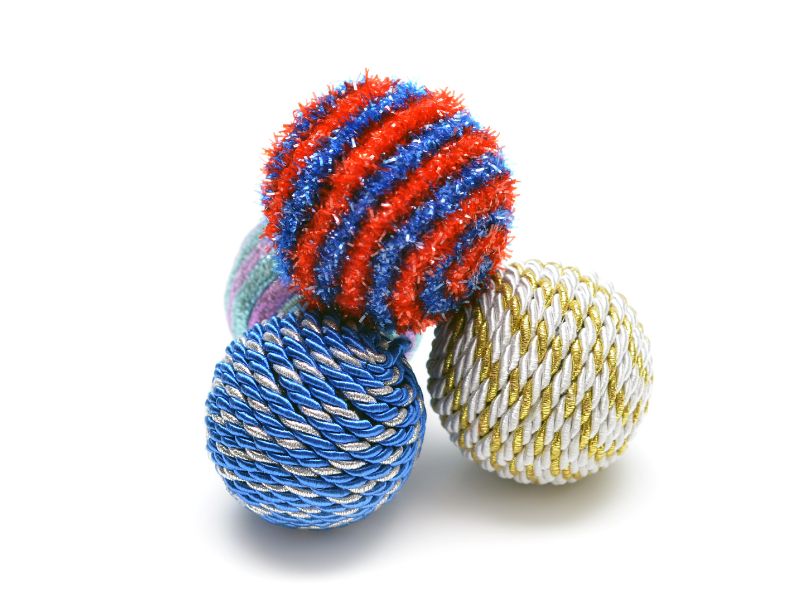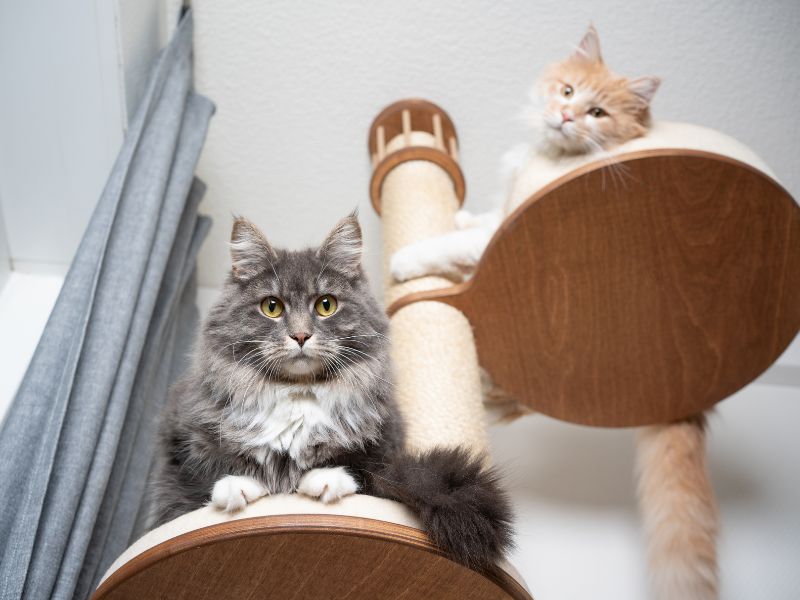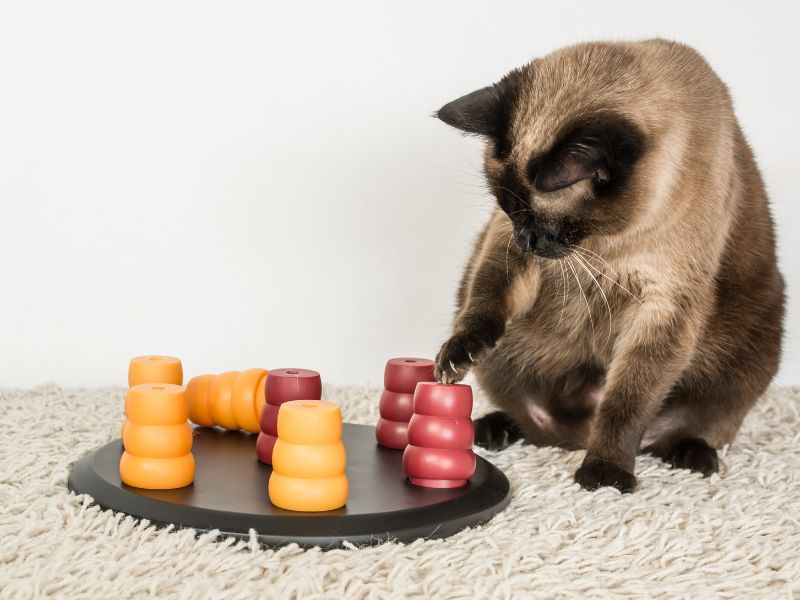Welcome to the world of responsible cat ownership! As a cat lover, you want to give your feline friend the best life possible, and that includes ensuring their safety indoors. While cats may seem independent, they still rely on us to protect them from potential dangers within our homes. Whether you have a curious kitten or an older cat who loves to explore, it’s essential to create a safe and stimulating environment that meets their needs. In this guide, we will explore a range of practical tips and expert advice on how to keep your cat safe indoors. From securing windows and balconies to creating a cat-friendly indoor space, we will cover everything you need to know to provide a secure haven for your beloved pet. So, let’s dive in and discover how to keep your cat safe and happy within the comfort of your home!
The Importance of Keeping Cats Safe Indoors
Cats are natural explorers, and their curiosity often leads them to venture outside. However, allowing your cat to roam freely outdoors can expose them to a myriad of dangers, including traffic accidents, predatory animals, and exposure to diseases. Keeping your cat indoors is the best way to protect them from these risks and ensure their safety.
Indoor cats typically live longer and healthier lives compared to their outdoor counterparts. They are less likely to contract infectious diseases, suffer injuries, or fall victim to accidents. By providing a safe indoor environment, you can give your cat the best chance of living a long and fulfilling life.
Indoor cats also have a reduced risk of getting lost or stolen. Cats are crafty escape artists, and even the most well-behaved cat can slip out of an open door or window. By keeping them indoors, you eliminate the possibility of them wandering off and potentially never finding their way back home.
In addition to the physical dangers, outdoor cats also face environmental hazards such as exposure to toxins, harsh weather conditions, and encounters with unfriendly animals. By keeping your cat indoors, you can protect them from these risks and ensure their overall well-being.
Potential Dangers of Letting Cats Roam Outside
Allowing your cat to roam freely outdoors may seem like a natural choice, but it comes with a host of potential dangers. One of the biggest risks is traffic accidents. Cats are small and agile creatures, making them difficult for drivers to see on busy roads. The result can be devastating, with many cats being injured or killed by moving vehicles.
Predatory animals are another threat to outdoor cats. Whether it’s a neighborhood dog or a wild predator, such as a coyote or fox, outdoor cats are at risk of being attacked. Even if your cat is a skilled hunter, they can become the hunted in a matter of seconds.
Diseases are also a concern for outdoor cats. They can come into contact with infected animals or contaminated environments, increasing their risk of contracting illnesses such as feline leukemia virus (FeLV), feline immunodeficiency virus (FIV), and rabies. These diseases can have serious health consequences and may even be fatal.
Outdoor cats are also more prone to injuries, such as bites, scratches, and abscesses from fights with other cats or animals. They are also at risk of getting trapped in tight spaces, injured by sharp objects, or exposed to poisonous plants and chemicals.
Considering these potential dangers, it becomes clear that keeping your cat indoors is the best way to ensure their safety and well-being.
Creating A Stimulating Indoor Environment for Your Cat
While keeping your cat safe indoors is essential, it’s equally important to provide them with a stimulating environment that meets their natural instincts and needs. Cats are curious animals that require mental and physical stimulation to thrive. Here are some tips on creating a cat-friendly indoor space:
- Vertical space: Cats love to climb and perch on high surfaces. Providing vertical space, such as cat trees or shelves, allows them to satisfy their natural climbing instincts and gives them a sense of security.
- Hiding spots: Cats also enjoy hiding and having their own cozy spaces. Place cardboard boxes, cat tunnels, or enclosed beds in different areas of your home to give them a sense of privacy and security.
- Window perches: Cats love observing the world from a safe vantage point. Install window perches or shelves near windows so your cat can enjoy watching birds, squirrels, and other outdoor activities.
- Interactive toys: Engage your cat’s hunting instincts with interactive toys that mimic prey. Toys that allow them to chase, pounce, and bat can provide hours of entertainment and mental stimulation.
- Puzzle feeders: Make mealtime more exciting by using puzzle feeders. These toys require your cat to work for their food, stimulating their natural foraging instincts and preventing boredom.
By incorporating these elements into your cat’s indoor environment, you can provide them with a stimulating and enriching space that mimics the outdoor world.

Providing Appropriate Scratching Posts and Toys
Cats have a natural urge to scratch, which helps them maintain healthy claws and mark their territory. To prevent your cat from scratching your furniture or carpets, it’s crucial to provide them with appropriate scratching posts or boards.
When choosing a scratching post, opt for sturdy and tall options that allow your cat to fully stretch their body. The material should be sisal rope or sisal fabric, as it provides a satisfying texture for scratching. Place the scratching post in an area where your cat spends a lot of time, such as near their favorite resting spot.
In addition to scratching posts, providing a variety of toys is essential for keeping your cat mentally and physically active. Interactive toys, such as wand toys or laser pointers, can engage your cat in play and provide much-needed exercise. Puzzle toys and treat dispensers can also keep them entertained and mentally stimulated.
Remember to rotate your cat’s toys regularly to prevent boredom. Introducing new toys and hiding others for a while can help keep their interest and excitement levels high.
Ensuring Your Home Is Cat-Proofed
Creating a safe indoor environment for your cat involves making sure your home is cat-proofed. Cats are curious creatures that can get themselves into all sorts of trouble if given the chance. Here are some measures you can take to ensure your home is safe for your feline friend:
- Secure windows and balconies: Cats are notorious for squeezing through small openings. Make sure your windows and balconies are securely screened or closed to prevent your cat from escaping or falling.
- Eliminate toxic plants and chemicals: Some common household plants, such as lilies, are toxic to cats. Remove any poisonous plants from your home or keep them out of your cat’s reach. Similarly, store chemicals, cleaning agents, and medications in secure cabinets.
- Cover electrical cords: Cats are drawn to electrical cords, which can pose a choking hazard or electrocution risk. Use cord covers or hide cords behind furniture to prevent your cat from gnawing on them.
- Secure loose objects: Cats love to explore and play with anything they find interesting. Secure loose objects, such as small decorations or loose wires, to prevent your cat from swallowing or choking on them.
- Hide fragile items: Cats are known for their agility and ability to knock things over. Place fragile items, such as vases or delicate ornaments, in secure areas where your cat cannot reach them.
By taking these precautions, you can minimize the potential risks and hazards within your home, providing a safe environment for your cat to explore and thrive.
The Benefits of Leash Training for Outdoor Exploration
If you’re concerned about your cat missing out on the outdoor experience, leash training can be a great compromise. Leash training allows your cat to explore the outdoors under your supervision, ensuring their safety while satisfying their curiosity.
Start by introducing your cat to a harness and leash indoors. Let them get used to wearing the harness before moving on to leash training. Use positive reinforcement, such as treats and praise, to reward your cat for accepting the harness and leash.
Once your cat is comfortable with the harness, you can start leash training in a safe and controlled outdoor space, such as your backyard or a quiet park. Allow your cat to explore at their own pace while keeping a close eye on their behavior. Gradually increase the duration and distance of the outdoor sessions as your cat becomes more comfortable.
Leash training can provide your cat with the mental and physical stimulation they crave while keeping them safe from outdoor dangers. It’s important to note that not all cats take to leash training, and some may find it stressful or restrictive. Always respect your cat’s comfort level and never force them into a situation they are not comfortable with.
Introducing A Catio or Enclosed Outdoor Space
If you have the space and resources, creating a catio or enclosed outdoor space can be the perfect solution for giving your cat a taste of the outdoors while keeping them safe. A catio is an enclosed area attached to your home, allowing your cat to experience fresh air, sunshine, and the sights and sounds of nature.
When designing a catio, consider the following:
- Use strong and durable materials to ensure the enclosure is secure and escape-proof.
- Provide different levels and platforms for your cat to climb and perch on.
- Include hiding spots, scratching posts, and toys to keep your cat entertained.
- Consider adding plants or cat-safe grass to create a more natural environment.
- Ensure the catio is accessible from inside your home, allowing your cat to come and go as they please.
A catio can be a wonderful addition to your home, providing your cat with the best of both worlds – the safety of indoor living and the enjoyment of outdoor experiences.

See Also: How Do I Train My Cat?
And: Practical Ways to Help Your Cat Reach Their Ideal Weight
Monitoring Your Cat’s Behavior and Mental Well-Being
Keeping your cat safe indoors goes beyond physical safety. It’s important to monitor your cat’s behavior and mental well-being to ensure they are happy and content within their indoor environment.
Keep an eye out for any changes in behavior, such as increased aggression, excessive hiding, or changes in appetite. These can be signs of stress or illness and should be addressed promptly. Providing environmental enrichment, such as interactive toys, puzzle feeders, and playtime, can help prevent boredom and reduce the likelihood of behavioral problems.
Regular veterinary check-ups are also crucial for maintaining your cat’s health and well-being. Your veterinarian can provide guidance on nutrition, vaccinations, and any specific health concerns based on your cat’s age and breed.
Tips For Transitioning an Outdoor Cat to An Indoor Lifestyle
If you have an outdoor cat that you want to transition to an indoor lifestyle, it’s important to approach the process gradually and with patience. Here are some tips to help make the transition smoother:
- Provide a safe and stimulating indoor environment: Before making the transition, ensure your home is cat-proofed and equipped with all the necessary resources to keep your cat entertained and stimulated.
- Introduce outdoor experiences indoors: Use interactive toys, puzzle feeders, and window perches to simulate outdoor experiences. This can help satisfy your cat’s natural instincts and reduce their longing for the outdoors.
- Increase play and exercise: Engage your cat in daily play sessions using interactive toys or wand toys. This can help burn off excess energy and keep them mentally and physically stimulated.
- Create a routine: Cats thrive on routine, so establish a consistent daily schedule for feeding, playtime, and rest. This can help provide a sense of security and stability during the transition period.
- Provide plenty of affection and love: Outdoor cats often have more freedom and independence, so it’s important to shower your indoor cat with love, attention, and affection. Spend quality time with them, grooming, cuddling, and engaging in interactive play.
- Consider harness training: If your cat still longs for outdoor exploration, consider leash training as a compromise. This can provide them with supervised outdoor experiences while ensuring their safety.
Remember, the transition from outdoor to indoor living may take time and patience. Be understanding of your cat’s needs and provide them with the support and reassurance they require during this period of adjustment.
Conclusion: The Key to Keeping Your Cat Safe and Happy Indoors
Keeping your cat safe and happy indoors is a responsibility that comes with being a responsible cat owner. By providing a secure and stimulating indoor environment, you can protect your cat from potential dangers while ensuring their overall well-being.
From securing windows and balconies to creating vertical space and providing interactive toys, there are many steps you can take to keep your cat entertained and mentally stimulated. Additionally, leash training and the creation of a catio or enclosed outdoor space can offer your cat the opportunity to experience the outdoors safely.
Monitoring your cat’s behavior and mental well-being is crucial to identifying any signs of stress or illness. Regular veterinary check-ups and environmental enrichment can help maintain your cat’s health and happiness.
If you have an outdoor cat that you want to transition to an indoor lifestyle, approach the process gradually and with patience. Provide a safe and stimulating indoor environment, increase play and exercise, and consider leash training as a compromise.
By following these tips and guidelines, you can create a secure haven for your beloved feline friend, ensuring they live a long, happy, and healthy life indoors.

